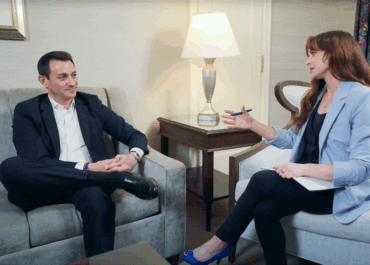How will technology shape the future of finance? What will be the impact of fintech companies and industry players?
At Symphony Innovate Asia 2019, Singapore’s top leaders in financial services came together to discuss the role of innovation and digital transformation across the industry. One of those leaders, Tinku Gupta, SGX’s Head of Technology, spoke with Angie Lau about the power of digitalization & collaboration, improving client service, and the future of the fintech landscape.
Read the full transcript of the conversation below:
Angie Lau, moderator:
Ms. Tinku Gupta on the stage. Thank you so much. So great to be here with you.
So I’ll share some behind the scenes with everybody. This is going to be very candid. I didn’t really give you a sense of what I would be asking you; that we just had a really nice “get to know you.” But I’ve done my research and I’d like to get to know you a little bit more through our audience today, and I hope if that’s okay with all of you, and yourself as well. Because when you think about an exchange, you really are in the business of regulation. You are in the business of staying inside the line. Doesn’t that run almost counterintuitive to what innovation truly is?
Tinku Gupta, Head of Technology, Singapore Exchange:
Thank you, Angie. Before I start, I should say that these days, being a woman and being in technology, it’s perhaps the best combination to have. Right? You kind of start with the benefit of the doubt. There are a lot of things happening around me in the exchange, and I’m here to share some of those.
So first, just to talk a little bit before going into innovation about what digitalization means to companies like us. I would say this is really for us to stay in the business. It’s about relevance, because in order for us to connect to our current and our future customers, it’s probably the only means. It’s just not the means. It’s a journey. The challenge that companies like us have is how quick the journey can be. Because the longer the journey takes, you are constantly dealing with customers with different needs. You cannot throw out your paper-based businesses, and at the same time, you cannot not provide services which your future and your digitized customers need. So that, I would say, is the challenge. And the opportunity for that is innovation. Because just because there are so many complexities, there are varying needs and there is a constant urge for speed and doing different things; it actually spurs a lot of innovation. To see now that you know what being a regulated entity and also a regulator is innovation far away from us. I would say no. Like any other businesses, we have to stay in business and we have to be innovative.
In my words, regulation actually powers innovation because if you don’t do things the right way, who you will impact is your customers at large. So you cannot say that because we are a regulated entity, we cannot innovate. That is not true. The question is, how do you do it in a controlled fashion? Our regulators here are actually leading by example. Regulators in many jurisdictions are actually leading by examples, and we are closely following that. Most important thing is today, nobody will ask me that, “Is SGX supporting cloud?” People today ask that, “Is SGX putting mission critical workload in cloud?” And the question and the answer to this can only be yes, if you put the right controls, the right regulation, write the rules in a new way. That’s really what we are doing. We are working with the cloud providers. We almost say that operating in cloud is really operating in multiple data centers. And what does it take for us to do that? So yes, regulation is extremely important for innovation.
Does that happen internally? Or what happens when innovation comes crowding in, and it’s less controlled environment? How do you then address it?
T. Gupta:
So, the concept here is … I always say it’s powered by SGX because that’s the whole idea. You need to really have a lot of these opportunities. Like for us, we have started to operate our retail-based services in the cloud, because there you have so many opportunities. And if you don’t do that, it is kind of less opportunities that you can pursue. We are also looking into, or actually, we are running market data services like index calculation in the cloud. So all of these actually come from different sorts of ideas and different opportunities.
The most important thing is how do you deal with these opportunities? Then we kind of start to work on, what is an operating framework for us? What kind of new skill set do we need? How do you make that work? So, I would say it is really more about being a market operator. Our main USP would be the network effect; how do you bring different kinds of capabilities, opportunities, players into this network and create a sustainable controlled environment for the customers?
A. Lau:
I mean, that’s really macro. That’s the philosophy. Clearly that’s embedded in the culture of you, your team, and SGX. But when you actually execute, there are challenges, right?
T. Gupta:
Yes, yes. Of course. There are challenges. Without challenges, there’s no fun. Right? Also, the main thing here is … We did last year an initiative with our regulators, which is to operate delivery versus payment process. I think many of … Because I saw a lot of banks here, so if people would understand what delivery versus payment is, where you deliver a product and you pay. The challenge that exchanges would have is, in our world of T+2, T+3 settlement, you don’t know which one comes first. So, do I take the cash first or do I get the securities first? That’s a challenge to handle.
What we have done is we actually proofed this concept together with the regulators to see that, okay you operate a distributed ledger for cash and securities, and you see how you inter-operate. What we also added to that is a concept of arbitrator, because we do appreciate and that’s where our exchange mindset or regulatory mindset comes in -that these things can fail. When it fails, what do you do? So there comes the role, and it may not be an exchange because the whole thing about technology today is this kind of roles can be performed by many different participants in the ecosystem. But we felt that that role is important, where you are able to deal with exceptions and not take technology as the one that always works because it does fail. And then what do we do? We then filed a patent with that because we wanted to make sure that this concept is being acknowledged as a new concept, where a regulator or an arbitrator plays an important role, even in this kind of innovation.
A. Lau:
You bring up a great point. I mean, what we look to exchange with and really exchange around the world in the same function, is a standard operating system. But with technology, it really transforms into swaps, many of these operating systems. And as you said, and you’ve characterized it, as technology fades. Where do you balance it off when you’re talking about interoperability or standardization?
T. Gupta:
So I think it’s a very interesting question, I would say, because when you talk about interoperability … You see, it’s kind of, I would say that it’s a bit of a paradox here. Because standardization can again not inspire innovation because everyone is doing the same way. Because the concept of innovation is one should disrupt the others, so you are constantly challenged that why this works this way. Right?
So the main thing is, again, if you think about that … if I am looking for a particular business model, that would remain a standard there. Because changing a business model altogether creates more havoc, I would say, because you need to bring the whole industry together. I would take a good example here, which is ASX’s way of replacing their clearing and settlement system with the blockchain. That movement, it’s quite exciting but it’s very difficult. So what can you do to create that core business model? Operate the way it operates, the way it has proven itself, and create utilities around this so that the standard is the core. The nonstandard are the different variations, and there you create new ideas. That one idea can challenge the other idea, and it can create so many opportunities.
I mean, personally and professionally, that’s something that excites me as Editor in Chief of Forecast News, that actually really takes a look at the real world applications of blockchain and explains it all to you in real language. What you’ve actually characterized with ASX is actually something that is still to be discussed as to whether or not that’s going to be an OS that everybody wants to adopt.
Now, SGX and Monetary Authority of Singapore recently came out in November and announced their own blockchain technology for settlement of tokenized assets. You’re also thinking about blockchain technology internally when it comes to innovation. Tell us a little bit about that.
T. Gupta:
Right. I briefly touched upon that before. We wanted to prove the concept of operating a delivery versus payment process. Delivery versus payment process is just a use case. There can be many such use cases where you have multiple parties and where you have multiple different kinds of products in the parties that are dealing with it. Right? So like I say, cash and securities.
We kind of wanted to still call it a proof of concept, but actually it can run. It runs today. But the question there is, when you run that concept in our core business, where is the adoption? Our next stage is then leverage that and kind of start to not only bring some of the participants into those blockchain, get their feedback. And at the same time evolve that into something which can string further. So, from delivery versus payment to payments.
While I keep saying it’s proof of concept for us, we want to make all of this work. We recently announced that we have worked with Amazon on a blockchain as a service. Because some of those things … I think the main hurdle for us is how do we incrementally invest and don’t invest too much so that there is no turn back? Many of those capabilities are coming up, and it’s kind of ready for us to use them and incrementally invest so that we don’t fail but we continuously grow.
A. Lau:
So you do then also innovate internally, but you also innovate externally and make your bets into the ecosystem as to where innovation is going to lead you? How do you take a look at those projects? What is the deciding factor for you and your team?
T. Gupta:
Yeah. So basically, broadly we are talking about use cases. So what kind of use cases does it work for in an exchange? Like I said, delivery versus payment was a useful use case. There are also other things … Actually, I have started, my team has started to work with Symphony to see how we can actually use some of these workflows in real business and do some real discussion around that. Because some of those will be already ingrained in our customers’ workflow. So how can we connect it?
I think an evolutionary question for us would be that, will it ever happen that we can actually match orders in the cloud? We hear about virtual bank a lot. Will there be a digital twin of an exchange of a market in a time to come? There are many challenges to deal with it in that, because it’s just not about operating a matching engine in the cloud. It is about giving customers a predictable latency. It is about the risk versus reward. And it is also about making sure that … How do we test it? Because these kinds of things, it is very difficult to test because there are so many variables. You have a latency, then you have a price time priority, which is an obligation for a market. Then the question is … We always think about digital twin. Digital twin is now being looked into a transportation system. So probably we need to look into some of those in a real business model, like having a digital twin of SGX and see how things work. These might sound very revolutionary now. But who knows? In time to come, these will be real.
A. Lau:
But the thing about the technology and the speed in which we are innovating, a lot has happened in the 365 days since Innovate 2018 back in Hong Kong. As David said, so much has happened since then. Where do you think fintech trends are heading to?
T. Gupta:
Right. I think as fintech trends … I think they’re getting more and more real. There was a time when I used to go to the state and say, “Well, I am also a fintech because we are dealing with financial technology.” But I think the concept of fintech, which I like, is really how do you think big and act small? Because if today there are some fintechs who are thinking that they will become an exchange, that’s the idea, right? That’s what fintech does for us. But then the question is, how do you use that and put it into your traditional business and make and reinvent that business? There are a lot more good products coming out of fintech. Nowadays, it is so common that when I speak to a vendor, the vendor first says that I’m not a fintech, and I will say, “What’s wrong with being a fintech?” Right?
There are lots of interesting opportunities, and what we have to build as kind of trying to get the best of both worlds, where our traditional businesses live and breathe, and at the same time we look into new opportunities, is how do you put that balance between when you kind of bring a product or a service offered by a fintech into your environment? How can you make it work so that … Again, there comes the question of regulation control and making it work the way our other services and platforms work.
The essence of this is really, how do you do it incrementally? How do you do it in an agile fashion? And how do you make sure that you are looking into where you are good at? Which is making sure that all the necessary so called failures are being addressed so that it does not impact customers in any adverse way.
A. Lau:
But I think Singapore, and really all of us here in the Asia Pacific region, have a very unique opportunity to lead fintech evolution technology solutions for global problems. So why do I say that? Asian economies are poised to overtake the world’s combined in less than a year; in 2020. That is the potential of the opportunities; the size and scope. And positioned here in Singapore, you’re taking a look at the Southeast Asia market of nearly a billion people, and you have apps that once connected drivers to people to transport them around now talking about becoming banks. This is really the speed of technology innovation. How are you going to participate with this growing? How are we all going to participate in this growing competitive landscape?
T. Gupta:
You know, it’s again, a lot of these answers getting into the same theme, right? Because first of all, we will participate because we can create the network effect. Because when I say network effect, meaning that when we participate, there are two things. First is, it is real because we tend to be a company who has this so called, I would say, an impression of being a regulator, so we would be careful. Being there and putting our skin in the game would actually give that assuredness that all this does work.
And second thing is really about, how do you make sure that you have all the right ingredients to get into this network effect? One side, it can be technology. One side would be the willingness to try these kinds of things. The virtual banking license has already happened. So tomorrow it will be really about Amazon getting a license to operate an exchange. Then what does it take for us to be in that game? What can we tell Amazon that, “Here, we can do better, and we want to be a partner in this.” Or, “We can be better as a face, so you should be our partner.” So again, building that ecosystem and making it work. We want to be in that game.
A. Lau:
So, forgive me if I go a little personal and to ask you … It really takes leadership and it really takes setting the culture of innovation as a mindset. You said this at the beginning of our conversation. What a great time it is to be a woman in technology. Why do you say that?
T. Gupta:
Actually in my team, I have more men than women, so I have to say that. I need to do more to promote diversity in my team. But having said that, I kind of think that women have a very important role to play because … I kind of think men are really very smart. But I also think that there is a bit of laziness in men. Right?
A. Lau:
Guys got to get back to work.
T. Gupta:
Yeah, you know? You need both. You need smart people, you need hardworking people. That is really where I kind of see that there are two things where women really play very important roles. It’s structure and effort. Then we compliment so well with our male colleagues, and together we make things happen.
A. Lau:
Make things happen is what we do. You know what I say? I say … Actually, I concur with a lot of that, except for the part where you said guys are lazy. I mean, my husband does do the laundry as well.
T. Gupta:
I have to say. In my family, I only have men around me. So-
A. Lau:
You got to do a lot of work. Look, 21st century leadership is about really combining the best characteristics of all of us. The male characteristics as well as the female characteristics.
So my last question for you before … To just leave us with some thoughts as to how we are to forge forward. We talk about technology, but I think it also boils back down to collaboration. How do you inspire your team? And indeed, what would you like to leave as a word of inspiration for our audience today?
T. Gupta:
Right. I think that I would say that, again here, I would take a bit of Gartner example. Because I like this concept that Gartner introduced, which is called Mode A and Mode B. Every team needs Mode A kind of people and Mode B kind of people. The Mode A kind of people who are predictable, who really knows how to make your engines work, asking all the difficult questions, putting right controls; and they need to be paired with the Mode B people who have no idea how to make things work, but they really ask you those questions which are extremely important. That, “Okay, this looks very simple,” they will come and say, and then they will say, “Yes, this is simple but you have to do this.”
You need that balance of Mode A and Mode B people to constantly challenge each other and create that healthy debate in the company. There is another term, which I always used with my team and it’s very common in our exchange world. We call it order to trade ratio. Because order is really about vibrancy. You need a lot of orders for a market to look vibrant. At the same time, for a market to look sustainable, you need to really match the right orders at the right time. How do you balance between the two so that you have the right appetite for having an order to trade ratio that can make a market look very sustainable? That is really the same culture that needs to resonate in our teams, where we are willing to try a lot of interesting stuff, but at the same time we want to make it successful. That’s really what I would leave this thing with.
A. Lau:
We share that same philosophy, all of us do, in this audience. We thank you for sharing that with us.
Thank you.
> A. Lau:
Ms. Tinku Guptu, everyone. Thank you.



